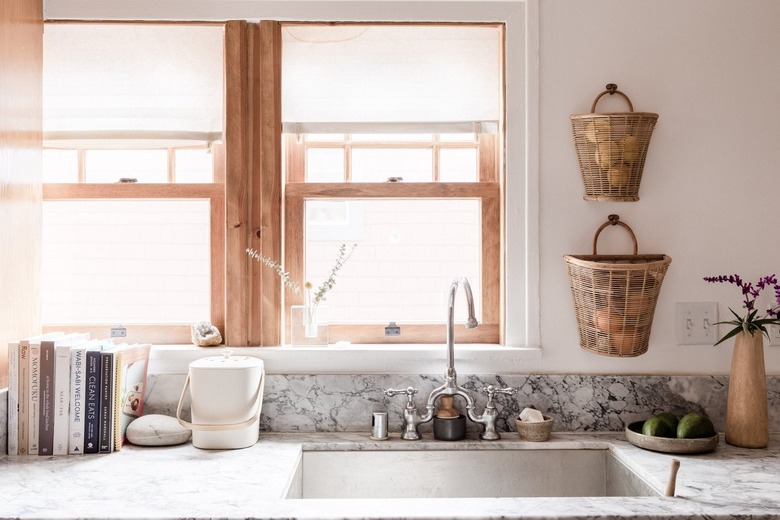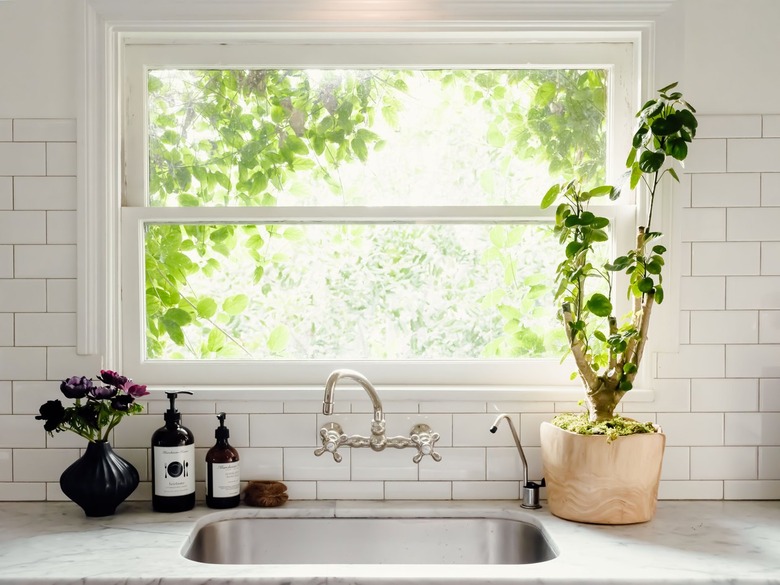What Is An Undermount Sink? The Pros And Cons Explained
We may receive a commission on purchases made from links.
Kitchen sinks are a must-have for the functionality of any culinary space, but they can also impact the overall design scheme. Luckily, they come in a variety of materials, sizes, and configurations, including the oh-so-popular undermount variety. As the name suggests, an undermount sink is one that is installed underneath the countertop, as opposed to a drop-in sink (which sits on top) and an integrated sink (which is a continuous extension of the countertop material). A classic farmhouse sink is a prime example of an undermount style basin.
In the days before running water and P-trap drains, a sink was little more than a bowl that sat on the kitchen table or counter. Eventually, homeowners got the idea to cut a hole in the countertop, or a recess in front of it, so the washstand could rest inside the cabinet, which lowered the rim to a more convenient level. And just like that, drop-in and farmhouse sinks were born and for many years after the development of modern plumbing, these were the only types of sinks available.
The undermount sink is a third option that started to become popular in the 1970s, along with new synthetic solid-surface countertop materials. It is fastened to the underside of the countertop and held in place by anchor posts that are secured by a strong adhesive or screwed into the underside of the countertop. Because this type of sink is normally used in conjunction with an upscale countertop material, it has gained a reputation for being more elegant than its top- and front-mounted counterparts. Over the years, undermount kitchen sinks have gained in popularity thanks in part to their many advantages.
Undermount Sink Pros
Undermount Sink Pros
One of the disadvantages of a traditional self-rimming sink is that the rim rests on top of the countertop. It forms a border around the sink that makes it more difficult to keep surfaces clean. Besides preventing you from wiping crumbs, spilled liquids, and dirt directly into the sink, the rim can actually collect build-up and debris. You generally seal the rim with caulk when installing the sink, but the caulk can wear out after a few years and allow water to seep underneath the rim and into the sink cabinet. Undermount sinks, on the other hand, avoid these problems.
Most culinary enthusiasts love undermount sinks because of the seamless finish and the fact that it doesn't take away from the beauty of the surrounding stone counter. And while this type of installation can be pricey when starting from scratch, if you're simply opting to replace an existing basin, you have a little more leeway. Beyond that, you also have the liberty to experiment with shapes outside of the standard rectangle such as oval and square sinks. Here are the major pros that come with an undermount kitchen sink:
- Sealed edges: While an undermount sink also has a rim, it's sealed to the underside of the countertop, so there's no border around the sink opening.
- Easy cleanup: Since the lip or edge of the sink is below the countertop, it is easy to wipe debris and messes right into the basin.
- Seamless look: Since the lip of the sink isn't visible, you'll have a more seamless finish, which will allow you to see more of your countertop.
- More room: Although it's really only a few inches, the style allows you to maximize a few extra valuable square inches of counter space.
Tip
Undermount sinks work only with solid countertops, such as those made from composite stone, solid-surface material, natural stone, or solid wood. They don't work with laminate countertops because the particleboard core of laminate is vulnerable to water damage. Nor do they work with ceramic tile countertops, which are usually built on a core of plywood.
Undermount Sink Cons
Undermount Sink Cons
Although there are many advantages to undermount sinks, the style is not immune to its share of downsides. A few cons and potential problem areas to keep an eye out for include:
- High price points: If you're looking for a budget model, this might not be the best bet. Undermount sinks cost, on average, about 50 percent more than a comparable drop-in sink.
- Increased installation costs: You'll need to pay a slightly higher labor cost for professional installation because undermount sinks are more difficult to install. You can expect to pay around $230.
- Potential to fall out: The anchors securing the sink to the underside of the countertop can become loose, causing the sink to sag or even fall.
- A break in the seal: If the silicone seal between the rim of the sink and the underside of the cabinet fails, water can seep past the rim and into the cabinet. Because you can't see the rim, this seepage could go on for a long time and cause a lot of damage before you're aware that it's even happening.
Undermount Sink Reveal Styles
Undermount Sink Reveal Styles
The edge of an undermount sink doesn't have to be completely hidden. It can be partially visible, or it can be flush with the edge of the countertop. The three available reveal options include:
- Negative reveal: The edge of the countertop overhangs the rim of the sink. This is the best-looking option, but it leaves the edge of the countertop more vulnerable to chipping, and it leaves a small lip on the underside of the countertop that can trap gunk.
- Positive reveal: The edge of the countertop bisects the rim, leaving part of the rim visible. This makes it easier to detect a leak, but the exposed rim can catch food particles and thick liquids.
- Zero reveal: The edge of the countertop aligns precisely with the inside of the sink bowl. This is the easiest configuration to keep clean, but because it calls for the most precision during installation, it may cost more to install.
Undermount Sink Materials
Undermount Sink Materials
When it comes to undermount kitchen sink materials, composite granite and porcelain-coated cast iron, while heavier, can provide a graceful complement to ceramic, stone, and wood countertops — providing they are sturdy enough to support the sink. The dark color of composite granite (which is manufactured with actual bits of real stone) provides a pleasing contrast in a predominately white setup. Cast iron sinks are usually coated with white porcelain, but a variety of other colors, including black, are also available.
The best materials for DIYers are lightweight options, such as copper and stainless steel sinks. These materials are easy to support and clean, and they look great with most countertops.


